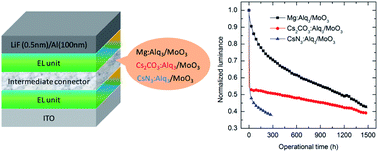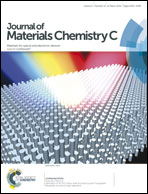The role of charge generation layers in the operational stability of tandem organic light-emitting diodes
Abstract
The influence of constituent materials and the operational stability of charge generation layers (CGLs) on the device characteristics of tandem organic light-emitting diodes (OLEDs) is reported upon. The CGLs between two vertically stacked emission units consist of an abrupt heterointerface between a MoO3 film and an n-type doped organic electron-transporting layer, where the n-type dopants vary from reactive metal (Mg) to metallic compounds (i.e., Cs2CO3 and CsN3). Contrary to the almost identical electron injection barriers modulated by the n-type dopants, the device characteristics and operational stability of tandem OLEDs are found to be sensitive to the doping constituent materials used in the CGLs. Using data on the electrical and spectral emission properties, electronic structures and the lifetime characteristics, it is identified that the degradation of the n-type doped layers in CGLs provides the main contribution to the device lifetime, due to the different doping mechanisms.


 Please wait while we load your content...
Please wait while we load your content...